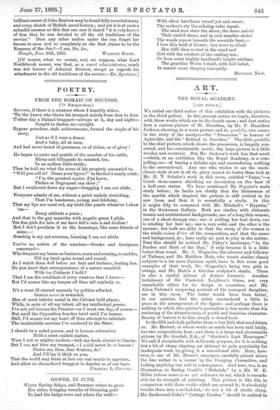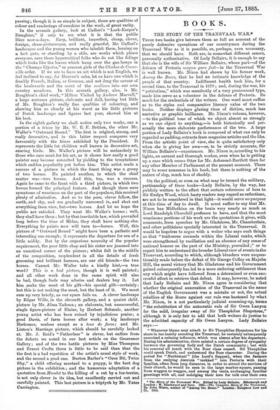ART.
THE ROYAL ACADEMY. [LAST NOTICE.] WE ended our third notice of this exhibition with the pictures in the third gallery. In this present notice we begin, therefore, with those works which are in the fourth room ; and first notice here a curious picture of St. Dorothea, by Mr. F. Hamilton Jackson, showing, in a main picture and its predella, two scenes in the story of the martyr,—the " Procession " in honour of Aphrodite, and the "Refusal to Sacrifice." The little predella to the chief picture, which shows the procession, is happily conceived, and has considerable merit ; the large picture is a little wooden and eccentric. But Mr. Jackson's work has that merit —which, at an exhibition like the Royal Academy, is a compelling one—of having a definite aim and surrendering nothing to the conventional. Any one who wishes to see the mockclassic style of art in all its glory cannot do better than look at Mr. H. T. Schafer's work in this room, entitled "Fame,"—a Greek stone-mason chiselling an inscription on the base of a half-seen statue. We have mentioned Mr. Poynter's nude study before; its faults are chiefly that the lifelessness of the marble which inspired the picture, is still evident in its new form, and that it is essentially a study. In this it might fitly be compared with Mr. Mitchell's " Hypatia," in the Grosvenor Gallery. Both are studies with elaborate mosaic and architectural backgrounds, one of a long thin woman, one of a short stumpy one ; one is pulling her hair down, one is winding her hair up ; one is very solid, and the other is the reverse ; but both are alike in that the study of the woman is the whole raison d'etre of the composition, and that the name and background, &c, have really no part to play in the matter. Near this should be noticed Mr. Fahey's landscape, "In the Burden and Heat of the Day," if only because it is a little better than usual. Mr. J. Weguelin, the admirer and follower of Tadema, and Mr. Matthew Hale, who treats similar classic subjects in a far more Parisian spirit, have in this room good examples of their work, Mr. Wegueliu's being two girls in swings, and Mr. Hale's a Grecian sculptor's studio. There is also a careful picture of Arthur Lemon's. Another instalment of Sir Frederick Leighton's frieze, not very remarkable either for its design or execution, and Mr. Alma Tadema's unsparing portrait of his youngest daughter, are in this room. The latter would have been better in our opinion, had the artist surrendered a little to grace in the arrangement of the figure ; and perhaps there is nothing in which this painter's perception is less acute than his rendering of the attractiveness of youth and feminine character. Beauty of feature is to him simply a closed book.
In the fifth and sixth galleries there is but little that need detain us. Mr. Herbert, of whose works so much has been said lately, has two compositions here; and there is a large and abominable picture by Mr. Goodall, R.A., of "Gordon's Last Messenger." We call it abominable with deliberate purpose, for it is nothing but a bit of cheap claptrap, an attempt to gain popularity for inadequate work by giving it a sensational title. Here, however, is one of Mr. Moore's seascapes, carefully placed above the line rather in a corner by the Hanging Committee, and.
looking anything but well in consequence. And here, too, is an illustration to Baring Gould's " Mehalah," by a Mr. W. E.
Miller (whose name is as yet unknown to us), which is remark able for its strength of painting. This picture is like life, in comparison with those works which are around it ; it absolutely knocks them into a cocked-hat,—to use a bit of studio slang. Mr. Sacheverel-Coke's "Cottage Garden" should be noticed in passing; though it is so simple in subject, there are qualities of colour and renderings of sunshine in the work, of great rarity.
In the seventh gallery, look at Caffieri's "Lock-Keeper's Daughter," if only to see what it is that the public likes now-a-days. Easy, brilliant, imperfect, cheap, clever, foreign, sham-picturesque, and really graceful, Mr. Caffieri's landscapes and the young women who inhabit them, leaning on a lock gate, or standing by a stile, are works which please everyone, save those hypercritical folks who do not like foliage which looks like the leaves which bang over the gas.lamps in the "Champs Elysees," or peasant girls of the Cloches de Contevile order. If we are to have an art which is not English, we feel inclined to say, for Heaven's sake, let us have one which is frankly French, Italian, or German, and not drag the savour of the boulevards and the scent of the coulisses into our own country meadows. In this seventh gallery, also, is Mr. Boughton's chief work, "Milton Visited by Andrew Marvell," a large costume picture, elaborate and dull, having but little of Mr. Boughton's really fine qualities of colouring, and showing him as clearly at his worst as his little pictures of Dutch landscape and figures last year, showed him at his best.
In the eighth gallery we shall notice only two works, one a portion of a frieze by Mr. W. E. F. Britten, the other Mr. Waller's "Outward Bound." The first is original, strong, and really decorative, and in this latter respect compares very favourably with the frieze exhibited by the President. It represents the little fat children well known in decorative art, snaring birds. Mr. Waller's picture will be melancholy to those who care most for his art, as it shows how easily a good painter may become conceited by yielding to the temptations which sadden popularity put before him. This artist made a success of a picture in which the finest thing was a group of two horses. He painted another, in which the chief matter was—two horses. And this, too, was a success. Again he came to the front with a third picture, in which two horses formed the principal feature. And though there were symptoms of weariness on the part of the populace, this received plenty of admiration. And so to the poor, clever fellow, the earth, and sky, and sea gradually narrowed in, and shut out everything from view, but—two horses. And let us hope the public are satisfied. They want Mr. Waller's horses ; well, they shall have them ; but by that inevitable law, which prevailed long before the time of Midas, they shall have nothing else. Estrything he paints now will turn to—horses. Well, this picture of "Outward Bound" might have been a, pathetic and interesting one enough ; it represents the departure for sea of a little middy. But by the imperious necessity of the popular requirement, the poor little chap and his sister are jammed into an unnoticed corner of the picture; whilst full in the middle of the composition, resplendent in all the details of fresh grooming and brilliant harness, are our old friends—the two horses. Cannot Mr. Waller take a kindly hint,—a true word ? This is a bad picture, though it is well painted ; and all other work done in the same spirit will also be bad, though fools may admire and dealers buy it. Let him _make the most of his gift—his special gift—certainly; but this is not making the most, but the least of it. We must sum up very briefly, as our space fails us. A clever landscape by Edgar Wills, in the eleventh gallery, and a quaint child_ picture by Mr. Alma Tadema ; an elaborate, but unsuccessful, single figure-picture of Elaine, by Herbert Schmalz, another young artist who has been ruined by injudicious praise ; a good Davis, of farm horses after work; a big landscape Herkomer, useless except as a tour de force; and Mr. Linton's Marriage picture, which should be carefully looked at. Mr. J. Reid's " Fatherless " is clever, but suffers from the defects we noted in our last article on the Grosvenor Gallery ; and of the two battle pictures by Miss Thompson and Ernest Crofts there is little to be said than that the the first is a bad repetition of the artist's usual style of wink, and the second a good one. Burton Barber's "Once Bit, Twice Shy," a child offering mustard to a puppy, is the best dog picture in the exhibition ; and the humorous adaptation of a quotation from Hamlet to the killing of a rat by a fox-terrier, is not only clever in its idea, but excellently carried out and carefully painted. This last picture is a triptych by Mr. Yates Carrington.



































 Previous page
Previous page